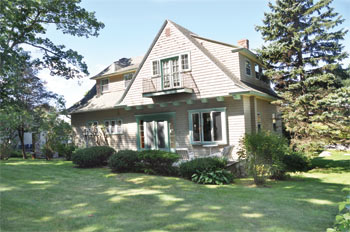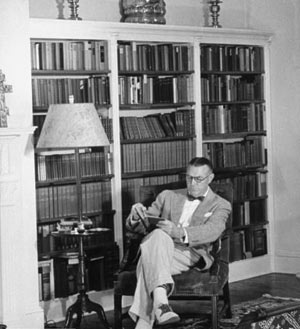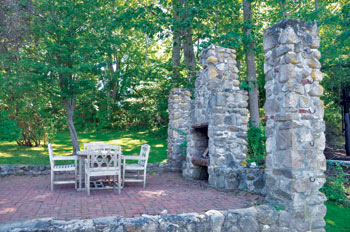October 2010
Off sea-swept Kennebunk Beach, a marvel of architectural salvage…
By Colin W. Sargent
 In 1919, future best-selling novelist Kenneth Roberts took a leap in the dark. Craving a place where he could hear himself think, he quit his job as a reporter for the Boston Post and moved to One Linden Avenue in Kennebunk Beach to write the stories that would make him famous.
In 1919, future best-selling novelist Kenneth Roberts took a leap in the dark. Craving a place where he could hear himself think, he quit his job as a reporter for the Boston Post and moved to One Linden Avenue in Kennebunk Beach to write the stories that would make him famous.
“Stall Hall” is where he dared create before he was “Kenneth Roberts.”
Listed for $840,000 today by Kennebunk Beach Realty, the former stable was purchased by the writer “on easy terms from a favorite aunt,” Lucy Tibbetts Russell, who owned “the mansion on the hill” next door.
Shelter Blogging, 1920s style
In those days, Webhannet Golf Course had not yet brightened his doorstep, so the stable lacked the views of the first green, first and second fairways, and second tee it enjoys today. Instead, Chez Roberts surveyed a swath of grassy countryside enlivened by a sea breeze.
Even as the links took shape across the street, the scribbler turned “Stall Hall” into a world-celebrated makeover project in a series of comic articles sending up the Colonial Revival craze of the 1920s and 1930s for the Saturday Evening Post.
Across two decades here, he lovingly–and cantankerously–transformed the forlorn stable into a handsome Shingle Style dream house with two inviting brick fireplaces, coffered ceilings, and exquisite crown molding.
More pizzazz was added when the young writer rescued a wrought-iron balcony from New Orleans and opened up a master-bedroom window with it. It’s still here.
During World War I, Roberts was a military intelligence officer stationed with the Siberian Expeditionary Force. So it’s an easy guess where the two ancient Russian icons built into the dark-pickle-paneled dining room walls came from.
Ditto for the authentic Colonial hinges everywhere in the house. Roberts was ahead of the curve here, embracing architectural salvage before its new wave of popularity today.
 Enormous burst of creativity
Enormous burst of creativity
Roughing it in his pine-paneled basement study, Roberts saw drafts of Arundel (1929) and The Lively Lady (1931) flow from the tip of his pen. He also wrote some loopy stuff at One Linden–how about Black Magic (1924), a book about Mussolini? Ever hear of Europe’s Morning After (1921), a disturbing travelogue through war-devastated tourist traps?
In that year, The Sunday Oregon described his fount of inspiration: “‘Stablehurst’ is what Kenneth Roberts, the author of Europe’s Morning After, called his beach home when he made over a stable into a residence at Kennebunk Beach, Maine. But it is said his literary neighbors, Booth Tarkington and Hugh Kahley, thought the name lacked elegance and they christened it ‘Stall Hall.’”
The Original money pit
To his credit, Roberts proudly embraced the more “elegant” title of Stall Hall, even though it spoofed his grandiloquence.
He even took up gardening here, surrounding Stall Hall with “excrescence” and “enough sweet william–a flower that leaves me as cold as Australian spinach or witch grass–to carpet the duchy of Luxembourg.”
Finally, at his zenith, he sold Stall Hall lock, stock, and black wicker furniture to remove to his new Kennebunkport mansion, Rocky Pasture. The latter has been so connected with Roberts that Stall Hall–where he first rolled up his sleeves and did his greatest work, the exciting first site where he most ardently “wanted to write”–has slipped below the radar.
The shriners’ magic summers
“My grandparents bought Stall Hall from Roberts in [1929] for $3,000,” seller Charlie Shriner, 61, tells us. “The first summer I came here, I was three months old.”
When we toured Stall Hall with Kennebunk Beach Realty’s Pat Foley, there was an overwhelming sense that “almost nothing has changed” since the author lived here. “Well, there used to be a screened porch,” Shriner says, “with swinging furniture in it,” that is now a green-slate terrace.
Entering via the lawn through a gracious French doors surmounted by Georgian Revival entablature, guests are dazzled by a great room paneled in beadboard with a warm, honey-gold finish. The large beams of the coffered ceilings are encased in the same material, while an enormous white-brick fireplace with Colonial hardware holds court on the opposite wall. Through the windows flickers the emerald green of the golf course.
“This room is my favorite,” Shriner says. “Sit down and you’ll want to stay here forever.”
 L’esprit de l’escalier
L’esprit de l’escalier
The original kitchen’s hinges date to the 1700s. It’s a friendly space lit by the gardens behind it, but “I understand that the next owner is going to put in a new kitchen.”
A landing from which many a “spirit of the stairway” must have been released to deputations below leads to Floor Two.
“The stairway went into the dining room, too, but my mother took it out to create the outdoor deck” facing Webhannet’s first [putting] green below yellow-and-white awnings. It’s a good move, a front-row ticket to the show.
Upstairs, the bedrooms charm in white shiplap, a natural pick for the author of The Lively Lady and Lydia Bailey. Another reminder that, yes, this was really a stable is a set of cast-iron stars that secure the suspension rods holding the second floor aloft.
Sure, the bathrooms need redecorating. Some wouldn’t have the heart to do it.
The basement is all knotty pine, with Roberts’s study and its built-in bookshelves a hallowed place for any writer to envy.
Which brings us to the conundrum: If a bombastic ghost lives in a house, how much redecorating can you do before you do violence to its zeitgeist?
At press time, we bumped into a letter on eBay (“Buy it now, $375”) postmarked August, 25, 1927, where Roberts jokes, “If you come back, I will play golf with you, but by God I cannot get under 89”–not so bad a score considering his other avocations. It’s just a quick shout out to a friend, a fellow Maine writer. Wickedly, Roberts has addressed it, “Wastebasket, Maine.”
In acerbic pencil, the forwarding postmaster has drily written, “Try Wiscasset.”
download the Kennebunk Beach Realty ad (.pdf)





0 Comments